The satisfaction of sinking your teeth into a crunchy, succulent apple picked from your own backyard is truly unmatched.
Apple trees are not only a source of delicious fruit, but they also add beauty to your landscape with their spring blossoms and summer foliage.
With a wide array of varieties available, choosing the right apple tree for your home can be an exciting journey.
Each variety has its unique characteristics, fruit qualities, and growth habits.
In this guide, we’ll explore 21 popular apple tree varieties to help you find the perfect fit for your home orchard.
Be sure you’re giving your new apple tree everything it needs to thrive. I explain it all in my detailed Apple Tree Guide. Check it out today!
1. Honeycrisp

The Honeycrisp apple tree is a favorite among many home growers for its exceptional fruit quality.
This medium to large-sized tree typically grows to around 15-20 feet in height and width. Dwarf Honeycrisp trees usually only reach 10-15 feet.
It’s known for its vigorous growth and hardy nature, making it a good choice for a variety of climates.
The fruit of the Honeycrisp is what truly sets it apart. The apples are large with a beautiful red-over-yellow color.
As the name suggests, they have a honey-sweet flavor with a crisp, juicy texture that’s refreshing to bite into. The apples are typically ready for harvest in late September.
Honeycrisp trees require cross-pollination to produce fruit, so they should be planted near another apple variety that blooms at the same time.
2. Gala
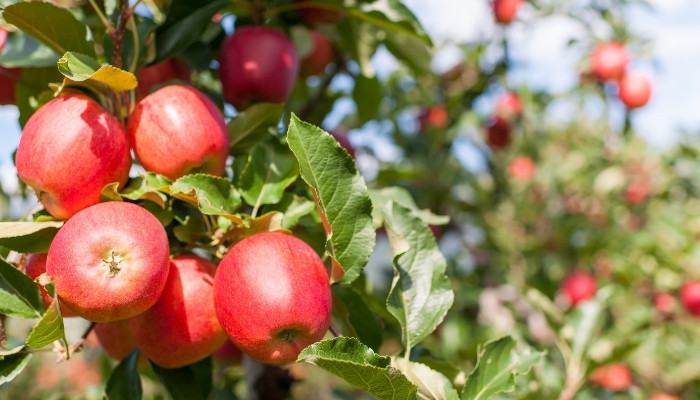
The Gala apple tree is a compact variety that’s perfect for smaller spaces. It typically grows to around 12-15 feet in height and width.
The tree is known for its attractive form and good disease resistance.
Gala apples are medium in size with distinctive yellow-orange skin with red striping. They have a sweet, mild flavor and a crisp texture.
These apples are versatile and can be used for fresh eating, cooking, and juicing. They’re usually ready for harvest in late August to early September.
Gala trees are partially self-fertile, but they’ll produce a larger crop if cross-pollinated with another apple variety.
3. Fuji
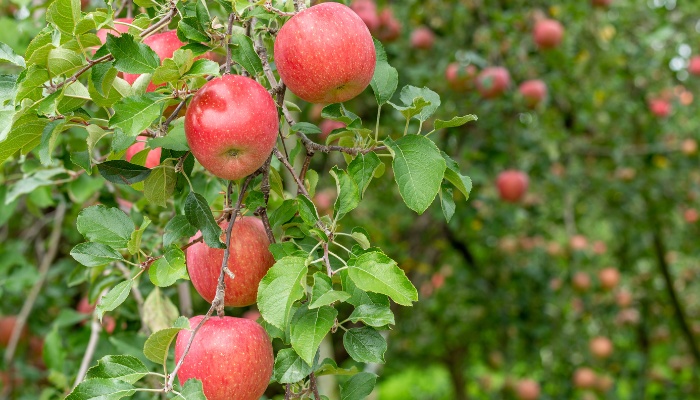
The Fuji apple tree is a large, vigorous variety that can reach heights and widths of up to 20-25 feet. Dwarf Fuji trees grow to 8-10 feet tall, and semi-dwarf versions usually reach 12-15 feet in height.
This variety is known for its strong growth and good disease resistance.
Fuji apples are large with yellow-green skin and red flush. They’re known for their super sweet flavor and firm, crisp texture.
Fuji apples store well, maintaining their quality for several months in proper storage conditions. They’re typically ready for harvest in mid to late October.
Like many apple varieties, Fuji trees benefit from cross-pollination for optimal fruit production.
4. Granny Smith

The Granny Smith apple tree is a large, vigorous variety that can grow up to 20-25 feet in height and width. It’s known for its hardiness and good resistance to apple scab.
Granny Smith apples are medium to large in size with vibrant green skin. They’re famous for their tart, tangy flavor and crisp, juicy texture.
These apples are versatile and excellent for both fresh eating and baking. They’re usually ready for harvest in late October to November.
Granny Smith trees are self-fertile, but cross-pollination can lead to a better yield.
5. Golden Delicious

The Golden Delicious apple tree is a medium to large-sized variety, typically growing to around 15-20 feet in height and width. It’s a reliable and hardy tree, known for its productivity and resistance to rust.
Golden Delicious apples are medium to large with a lovely golden-yellow skin. They have a sweet, mellow flavor and a crisp texture.
These apples are excellent for fresh eating, cooking, and baking. They’re typically ready for harvest in late September to early October.
Golden Delicious trees are self-fertile, making them a good choice for a home grower who only has space for one tree.
However, like other apple varieties, they can benefit from cross-pollination for a larger yield.
6. Red Delicious
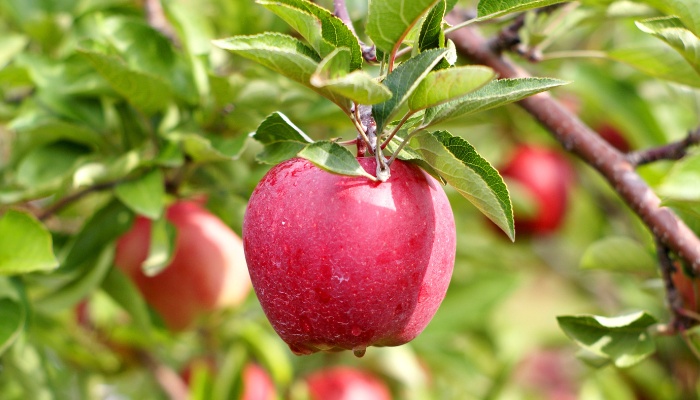
The Red Delicious apple tree is a large, robust variety that can reach heights and widths of up to 20-25 feet. It’s known for its productivity and the attractive, upright form of the tree.
Red Delicious apples are large with deep-red skin. They have a sweet, mild flavor and a somewhat softer texture compared to other varieties.
These apples are best for fresh eating and are typically ready for harvest in late September.
Red Delicious trees are partially self-fertile, but they’ll produce a larger crop if cross-pollinated with another apple variety.
7. Pink Lady
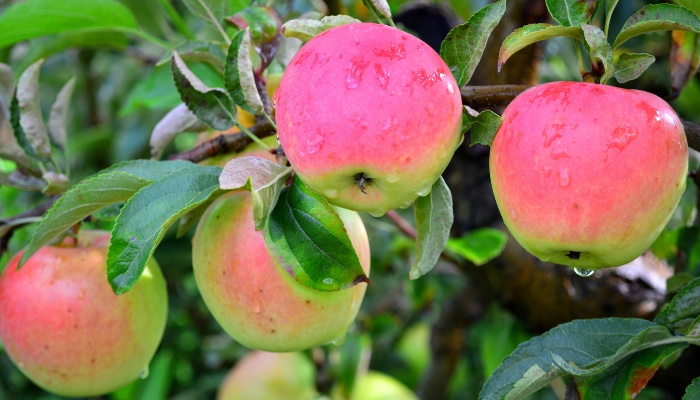
The Pink Lady apple tree, also known as Cripps Pink, is a medium-sized variety that typically grows to around 15-20 feet in height and width. It’s known for its vigorous growth and good disease resistance.
Pink Lady apples are medium to large with a pink blush over a yellow-green background. They have a unique tart-sweet flavor and a firm, crisp texture.
These apples store well and are typically ready for harvest in late October to November.
Pink Lady trees require a long growing season and do best in warmer apple-growing regions. They also require cross-pollination with another apple variety.
8. McIntosh

The McIntosh apple tree is a medium-sized variety, typically growing to around 15-20 feet in height and width. It’s known for its hardiness and the attractive, round form of the tree.
McIntosh apples are medium in size with a red blush over a greenish-yellow background. They have a tart, refreshing flavor and a tender, juicy texture.
These apples are versatile and can be used for fresh eating, cooking, and cider making. They’re usually ready for harvest in mid to late September.
McIntosh trees are partially self-fertile, but they’ll produce a larger crop if cross-pollinated with another apple variety.
9. Jonagold

The Jonagold apple tree is a large, vigorous variety that can grow up to 20-25 feet in height and width. It’s a cross between Jonathan and Golden Delicious, combining the best qualities of both parents.
Jonagold apples are large with yellow-green skin and a red blush. They have a balanced sweet-tart flavor and a crisp, juicy texture.
These apples are excellent for both fresh eating and cooking. They’re typically ready for harvest in mid to late October.
Jonagold trees are triploid, meaning they have an extra set of chromosomes. They are sterile and require cross-pollination with two other apple varieties.
10. Braeburn

The Braeburn apple tree is a medium to large-sized variety, typically growing around 15-20 feet in height and width. It’s known for its productivity and good resistance to apple scab.
Braeburn apples are medium to large with a red blush over a yellow-green background. They have a balanced sweet-tart flavor and a firm, crisp texture.
These apples store well and are typically ready for harvest in late October to November.
Braeburn trees require a long growing season and do best in warmer apple-growing regions. They also require cross-pollination with another apple variety.
11. Rome Beauty

The Rome Beauty apple tree is a medium to large-sized variety, typically growing to around 15-20 feet in height and width. It’s known for its hardiness and the attractive, round form of the tree.
Rome Beauty apples are large with deep-red skin. They have a mildly tart flavor and a firm texture.
These apples are excellent for cooking, especially baking, as they hold their shape and flavor well. They’re typically ready for harvest in mid to late October.
Rome Beauty trees are partially self-fertile, but they’ll produce a larger crop if cross-pollinated with another apple variety.
12. Dorsett Golden
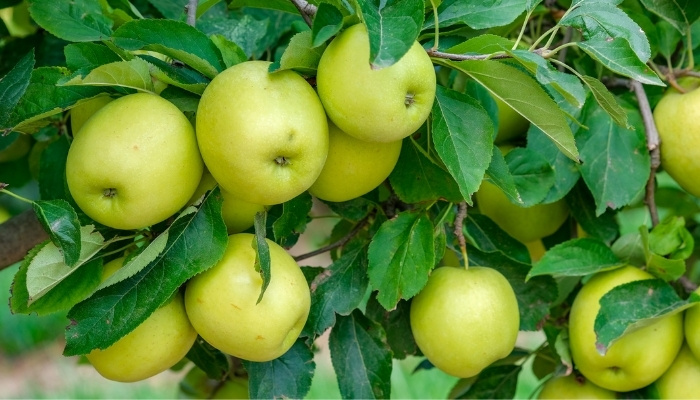
The Dorsett Golden apple tree is a medium-sized variety that typically grows to 10-15 feet in height and width.
It’s known for its productivity and its ability to adapt to warmer climates where other apple varieties may struggle.
Dorsett Golden apples are medium-sized with yellow skin and a slight red blush. They have a sweet, mild flavor and a crisp texture.
These apples are excellent for fresh eating and are typically ready for harvest in late June to July, making them one of the earliest ripening apple varieties.
Dorsett Golden trees require cross-pollination with another apple variety. They are an excellent choice for warmer climates that don’t meet the chilling requirements of many other apple varieties.
13. Cortland

The Cortland apple tree is a medium to large-sized variety, typically growing to 15-20 feet in height and width.
It’s a cross between McIntosh and Ben Davis and is known for its hardiness and good resistance to apple scab.
Cortland apples are medium to large with a red blush over a yellow-green background. They have a balanced sweet-tart flavor and a tender, juicy texture.
These apples are versatile and can be used for fresh eating, cooking, and cider making. They’re usually ready for harvest in late September.
Cortland trees are partially self-fertile, but they’ll produce a larger crop if cross-pollinated with another apple variety.
14. Empire

The Empire apple tree is a medium-sized variety, typically growing to 15 feet in height and width.
It’s a cross between McIntosh and Red Delicious and is known for its productivity and good resistance to apple scab and mildew.
Empire apples are medium in size with deep-red skin. They have a sweet-tart flavor and a crisp, juicy texture.
These apples are excellent for fresh eating and are typically ready for harvest in late September to early October.
Empire trees are partially self-fertile, but they’ll produce a larger crop if cross-pollinated with another apple variety.
15. Northern Spy
The Northern Spy apple tree is a large, vigorous variety that can grow up to 20-25 feet in height and width. It’s known for its hardiness and the attractive, upright form of the tree.
Northern Spy apples are large with a red blush over a greenish-yellow background. They have a tart, rich flavor and a firm, juicy texture.
These apples are excellent for both fresh eating and cooking, especially for pies. They’re typically ready for harvest in late October to November.
Northern Spy trees are late bloomers and require cross-pollination with another apple variety.
They also tend to be biennial bearers, meaning they produce a heavy crop one year and a lighter crop the next.
16. Crispin
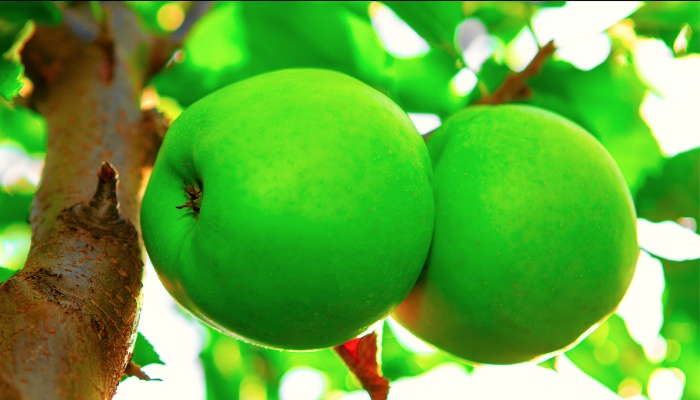
The Crispin apple tree, also known as Mutsu, is a large, vigorous variety that can grow up to 20-25 feet in height and width.
It’s a cross between Golden Delicious and Indo and is known for its productivity and good resistance to apple scab.
Crispin apples are large with green to yellow skin. They have a sweet, slightly tart flavor and a firm, crisp texture.
These apples are excellent for both fresh eating and cooking. They’re typically ready for harvest in late October.
Crispin trees are partially self-fertile, but they’ll produce a larger crop if cross-pollinated with another apple variety.
17. Winesap
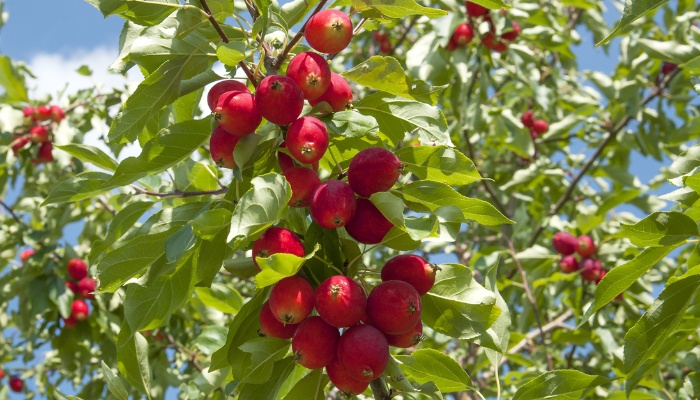
The Winesap apple tree is a medium to large-sized variety, typically growing to around 15-20 feet in height and width. It’s known for its hardiness and the attractive, round form of the tree.
Winesap apples are medium in size with deep-red skin. They have a tart, wine-like flavor and a firm, crisp texture.
These apples are excellent for both fresh eating and cider making. They’re typically ready for harvest in late October to November.
Winesap trees are partially self-fertile, but they’ll produce a larger crop if cross-pollinated with another apple variety.
18. Jonathan
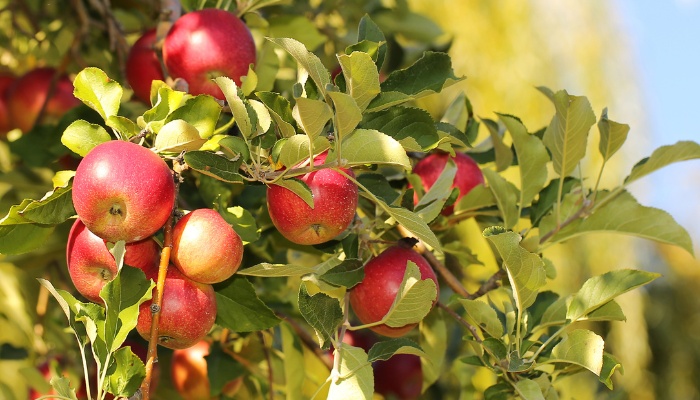
The Jonathan apple tree is a medium-sized variety, typically growing to 15 feet in height and width. It’s known for its productivity and good resistance to apple scab.
Jonathan apples are medium in size with red blush over a yellow-green background. They have a balanced sweet-tart flavor and a crisp texture.
These apples are versatile and can be used for fresh eating, cooking, and cider making. They’re usually ready for harvest in mid to late September.
Jonathan trees are partially self-fertile, but they’ll produce a larger crop if cross-pollinated with another apple variety.
19. Ambrosia

The Ambrosia apple tree is a medium-sized variety that typically reaches 15 feet in height and width. It’s a relatively new variety, discovered as a chance seedling in British Columbia, Canada.
Ambrosia apples are medium to large with a pink blush over a yellow background. They have a sweet, honeyed flavor and a crisp, juicy texture.
These apples are excellent for fresh eating and are typically ready for harvest in late September to early October.
Ambrosia trees are partially self-fertile, but they’ll produce a larger crop if cross-pollinated with another apple variety.
20. Cameo
The Cameo apple tree is a medium to large-sized variety, typically growing to 15-20 feet in height and width. It’s a relatively new variety, discovered by chance in Washington State, USA.
Cameo apples are medium to large with a red stripe over a yellowish-cream background. They have a balanced sweet-tart flavor and a firm, crisp texture.
These apples are excellent for both fresh eating and cooking. They’re typically ready for harvest in late October.
Cameo trees are partially self-fertile, but they’ll produce a larger crop if cross-pollinated with another apple variety.
21. Gravenstein

The Gravenstein apple tree is a medium-sized variety, typically growing to 10-15 feet in height and width. It’s an old variety, known for its productivity and good resistance to apple scab.
Gravenstein apples are medium to large with a red blush over a green or yellow background. They have a tart, rich flavor and a firm, juicy texture.
These apples are excellent for cooking, especially for making apple sauce or cider. They’re typically ready for harvest in late July to August, making them one of the earliest ripening apple varieties.
Gravenstein trees are partially self-fertile, but they’ll produce a larger crop if cross-pollinated with another apple variety.
Conclusion
Choosing the right apple tree for your home orchard is a delightful endeavor.
With so many varieties available, each with its unique characteristics and fruit qualities, you can find the perfect apple tree that suits your taste and garden conditions.
Whether you prefer the honey-sweet flavor of the Honeycrisp, the tartness of the Granny Smith, or the balanced sweetness of the Gala, there’s an apple tree out there for you.
Remember that the key to successful apple tree growing is understanding the needs of your chosen variety and providing the right care.
